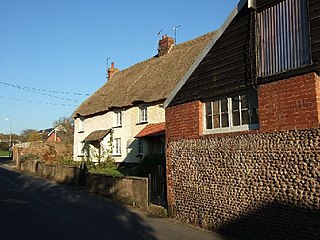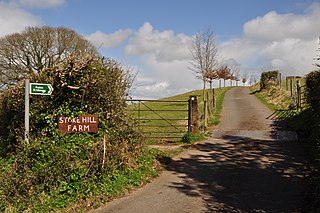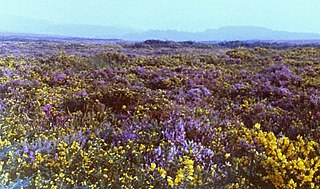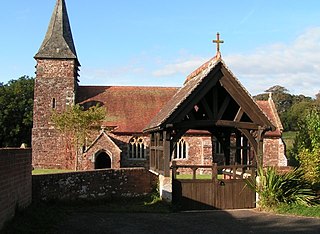
East Devon is a constituency represented in the House of Commons of the UK Parliament since 2019 by Simon Jupp of the Conservative Party.

Woodbury is a village and civil parish in East Devon in the English county of Devon, 7 miles (11 km) south east of the city of Exeter. At the 2011 Census the village had a population of 1,605, and the parish had a population of 3,466. It lies on the east bank of the Exe Estuary, has borders – clockwise from the estuary – with the district of Exeter and then the parishes of Clyst St George, Clyst St Mary, Farringdon, Colaton Raleigh, Bicton and Lympstone. Woodbury is part of the electoral ward of Woodbury and Lympstone whose population at the 2011 Census was 5,260.

Cadhay is an historic estate in the parish of Ottery St Mary in Devon, England, 10 miles (16 km) east of Exeter and 5 miles (8 km) from the sea at Sidmouth. The mansion house known as Cadhay House, 1 mile (2 km) north-west of Ottery St Mary village, is a grade I listed Elizabethan building.

Bicton is a civil parish and a former manor in the East Devon district of Devon, England, near the town of Budleigh Salterton. The parish is surrounded, clockwise from the north, by the parishes of Colaton Raleigh, Otterton, East Budleigh and Woodbury. According to the 2001 census it had a population of 280. Much of the parish consists of Bicton Park, the historic home of the Rolle family, with Bicton Common, adjacent to Woodbury Common, in the west. The parish includes the village of Yettington on its southern border.

Stoke Hill is a large hill rising to the north of Exeter in Devon, England. It is significant as the site of both an Iron Age hill fort and a later Roman signal station.

Woodbury Common in East Devon, England is an area of common land that is predominantly heathland adjacent to the village of Woodbury. It is bordered to the south by the edge of the towns of Exmouth and Budleigh Salterton, the hamlet of Yettington to the east, and the A3052 to the north. It is part of the East Devon Area of Outstanding Natural Beauty, and is a Site of Special Scientific Interest.

There are two hills named Castle Hill within the immediate environs of Great Torrington in Devon, England. The first is within the town and is the site of the Norman & mediaeval castles, but was probably an Iron Age hill fort before this.50.9509°N 4.1436°W

Stockland Castle is the name given to two Iron Age hill forts on Stockland Hill close to Stockland in Devon, England. Stockland Great Castle occupies a position on the eastern slope of the hill at 190–210 metres (620–690 ft) above sea level. Stockland Little Castle, located about 1 kilometre (0.6 mi) northeast of its larger neighbour, occupies a small promontory on the eastern slope of the hill at approximately 175 metres (574 ft) above sea level.

Castle Dyke is an Iron Age hill fort situated between Chudleigh and Dawlish in Devon, England. The fort is situated on a Hilltop at approx 140 metres above sea level.
Holne Chase Castle is an Iron Age hill fort situated close to Buckland-in-the-Moor in Devon, England. The fort is situated on a promontory on the Northern slopes of Holne Chase in Chase Wood at approx 150 Metres above Sea Level overlooking the River Dart.

Brent Hill is the site of an Iron Age hill fort situated close to South Brent in Devon, England. The fort occupies the top of Brent Hill at approx 311 Metres above Sea Level.
Yellowberries Copse is an Iron Age enclosure, or possibly hill fort situated South of South Brent in Devon, England. The fort is situated on the North West slope of Cutwell Hill at approx 155 Metres above Sea Level.

Slapton Castle is an Iron Age hill fort situated close to Slapton in Devon, England. The fort is on a promontory on the eastern side of a hilltop at approximately 65 metres (213 ft) above sea level, overlooking Slapton Ley.
Woodbury is an Iron Age hillfort situated in the parish of Stoke Fleming, close to Dartmouth in Devon, England. The fort is situated on a promontory on the southern side of Norton Down at approximately 145 metres (476 ft) above sea level.

Capton is a village near Dartmouth in Devon, England.

Farringdon is a village, civil parish and former manor in the district of East Devon in the county of Devon, England. The parish is surrounded clockwise from the north by the parishes of Clyst Honiton, Aylesbeare, a small part of Colaton Raleigh, Woodbury, Clyst St Mary and a small part of Sowton.

Kenn is a village and civil parish situated in Devon, England, several miles to the south of Exeter. It lies in the district of Teignbridge, and at the 2001 census had a population of 968.

Today Clyst Heath is a suburb to the south east of the city of Exeter, Devon, England. An area of relatively high ground to the west of the River Clyst, it remained heathland until the early nineteenth century when it was cultivated for the first time.

Nutwell in the parish of Woodbury on the south coast of Devon is a historic manor and the site of a Georgian neo-classical Grade II* listed mansion house known as Nutwell Court. The house is situated on the east bank of the estuary of the River Exe, on low-lying ground nearly contiguous to the water, and almost facing Powderham Castle similarly sited on the west bank. The manor was long held by the powerful Dynham family, which also held adjacent Lympstone, and was according to Risdon the site of their castle until John Dynham, 1st Baron Dynham (1433–1501), the last in the male line, converted it into "a fair and stately dwelling house".
Cromarty Castle was a castle in Cromarty, Scotland. Cromarty, then known as Crumbathyn, was created a royal burgh in the reign of King Alexander I of Scotland. Cromarty overlooks the entrance to the Cromarty Firth and was strategically important. A motte-and-bailey castle was built in the 12th–13th century. The castle was held by Sir William de Monte Alto during the Scottish wars of independence for both the English and the Scottish.

















